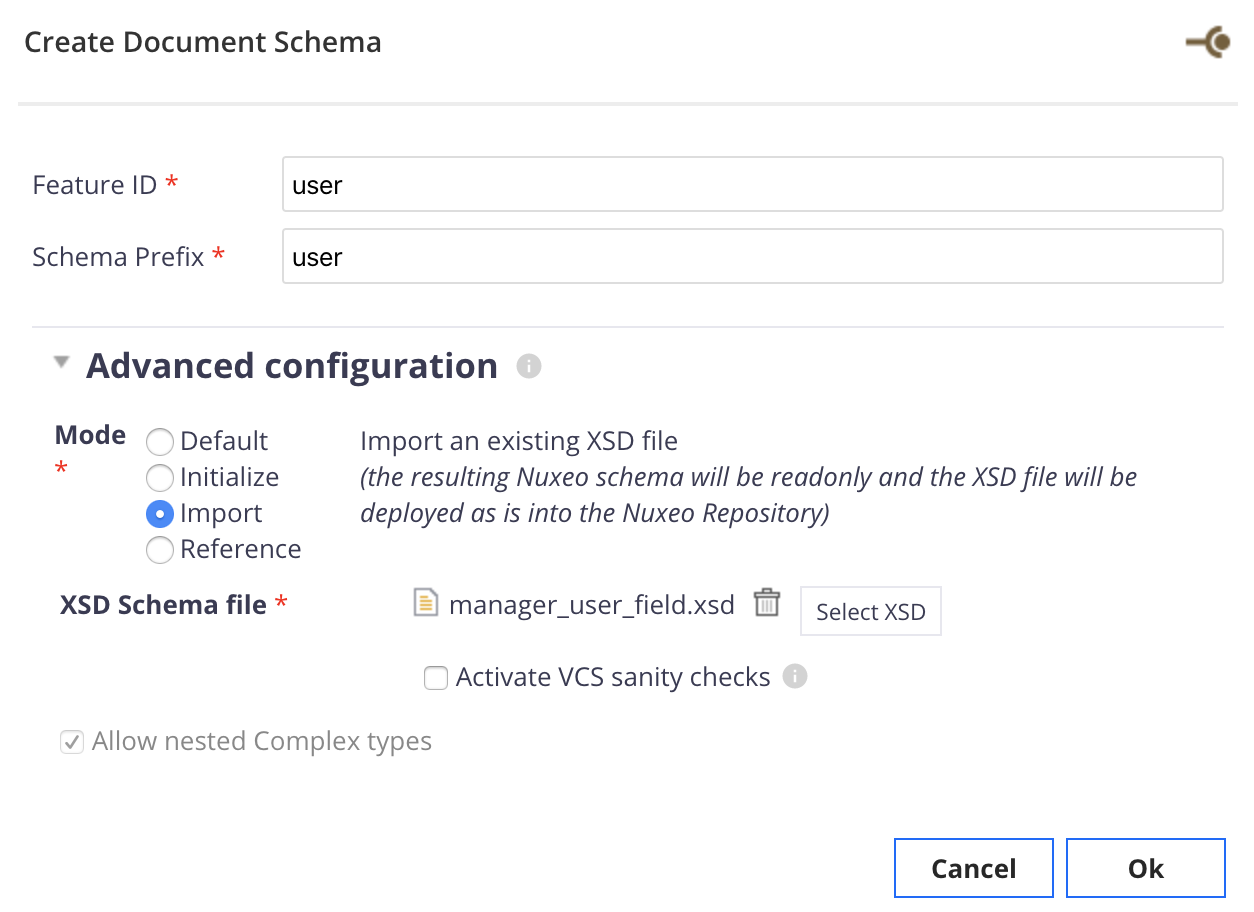Users and groups are defined using schemas and, as an Extensible Platform, Nuxeo gives you the ability to modify or add schemas.
Prerequisite
This page gives the step by step instructions to deploy new user information in Nuxeo Platform. For the UI configuration, it assumes you have the Nuxeo Web UI addon deployed.
Extending User Properties
Let's add a new user property called manager, corresponding to the current user's manager. This information would be helpful in the workflow context (for reassignment, escalation rules etc.)
Create the New User Property
Create a manager_user_field.xsd file with the following content from the default user schema definition:
<?xml version="1.0"?>
<xs:schema targetNamespace="http://www.nuxeo.org/ecm/schemas/user"
xmlns:xs="http://www.w3.org/2001/XMLSchema"
xmlns:nxs="http://www.nuxeo.org/ecm/schemas/user">
<xs:include schemaLocation="base.xsd" />
<xs:element name="username" type="xs:string" />
<xs:element name="password" type="xs:string" />
<xs:element name="firstName" type="xs:string" />
<xs:element name="lastName" type="xs:string" />
<xs:element name="company" type="xs:string" />
<!-- here is my new user field -->
<xs:element name="manager" type="xs:string" />
<xs:element name="email">
<xs:simpleType>
<xs:restriction base="xs:string">
<!-- the same pattern is used in userinfo.xsd -->
<xs:pattern value="[^@]+@[^\.]+\..+" />
</xs:restriction>
</xs:simpleType>
</xs:element>
<!-- inverse reference -->
<xs:element name="groups" type="nxs:stringList" />
<!-- tenant id for the user -->
<xs:element name="tenantId" type="xs:string" />
</xs:schema>
Deploy the New Field in Studio Modeler
- Open you Nuxeo Studio Project and Navigate to Studio Modeler > CONFIGURATION > Resources > Schemas
- Upload the
manager_user_field.xsdfile Go to CONFIGURATION > Content Model > Schemas and click on New. Fill in the popup window like this:


Click on Ok.
- Go to CONFIGURATION > Advanced Settings > XML Extensions and create a new XML extension (called for example
USER_SCHEMA_EXTENSION) with the following content:<require>org.nuxeo.ecm.directory.types</require> <extension point="schema" target="org.nuxeo.ecm.core.schema.TypeService"> <schema name="user" override="true" src="data/schemas/manager_user_field.xsd"/> </extension> - To check that those steps were effective, check into your database that the fields are present in the users table after synching your project server-side and restarting Nuxeo.
Display the New Field in Web UI
This new field has to be displayed in all the pages related to the user information.
It includes:
- The user edition form to create and update the new property:
- The user information page to view the new property:
Edit Layout
- In Designer, go to Resources and create a folder under UI called
nuxeo-user-group-management. We will create all the next elements in this folder. - Create a new element
nuxeo-edit-user. - Replace the existing content by the element
nuxeo-edit-user.html - Add:
<nuxeo-user-suggestion value="" label="[[i18n('user.manager')]]" search-type="USER_TYPE" name="manager"></nuxeo-user-suggestion>
View Layout
- Create a folder called
nuxeo-user-group-managementunder UI. - In this folder, create a new element
nuxeo-view-user. - Replace the existing content by the element
nuxeo-view-user.html - Add the following lines:
<div class="layout vertical flex">
<label>[[i18n('user.manager')]]</label>
<nuxeo-user-tag user="[[user.properties.manager]]"></nuxeo-user-tag>
</div>
Translate the New Field
Add a new entry in your translation file (messages.json by default) with:
{
...
"user.manager":"Manager"
...
}
Deploy Your Changes
- User Creation and Edition Layout


- User View Layout


User and Group References
Whenever you contribute to a schema referencing another schema or document, you must define the references and inverse references.
On that particular case, you also have to define directories to specify the way schemas are linked to each other.
The relation between user and groups uses a directory called groupDirectory is defined as follow:
<?xml version="1.0"?>
<component name="org.nuxeo.ecm.directory.storage">
<require>org.nuxeo.ecm.platform.digestauth.config</require>
<extension target="org.nuxeo.ecm.directory.GenericDirectory" point="directories">
<directory name="groupDirectory" extends="template-group">
<schema>group</schema>
<types>
<type>system</type>
</types>
<idField>groupname</idField>
<dataFile>groups.csv</dataFile>
<createTablePolicy>on_missing_columns</createTablePolicy>
<autoincrementIdField>false</autoincrementIdField>
<cacheEntryName>group-entry-cache</cacheEntryName>
<cacheEntryWithoutReferencesName>group-entry-cache-without-references</cacheEntryWithoutReferencesName>
<references>
<reference field="members" directory="userDirectory"
name="user2group" source="groupId" target="userId"
dataFile="user2group.csv"/>
<reference field="subGroups" directory="groupDirectory"
name="group2group" source="parentGroupId"
target="childGroupId"/>
<inverseReference field="parentGroups" directory="groupDirectory"
dualReferenceField="subGroups"/>
</references>
</directory>
</extension>
</component>
The customization of the groups is similar to the users.
The default group schema definition:
<?xml version="1.0"?>
<xs:schema targetNamespace="http://www.nuxeo.org/ecm/schemas/group"
xmlns:xs="http://www.w3.org/2001/XMLSchema"
xmlns:nxs="http://www.nuxeo.org/ecm/schemas/group">
<xs:include schemaLocation="base.xsd" />
<xs:element name="groupname" type="xs:string" />
<xs:element name="grouplabel" type="xs:string" />
<xs:element name="description" type="xs:string" />
<!-- references -->
<xs:element name="members" type="nxs:stringList" />
<xs:element name="subGroups" type="nxs:stringList" />
<!-- inverse reference -->
<xs:element name="parentGroups" type="nxs:stringList" />
<!-- multi tenant -->
<xs:element name="tenantId" type="xs:string" />
</xs:schema>
The group schema can be extended as well using an extension:
<extension target="org.nuxeo.ecm.core.schema.TypeService" point="schema">
<schema name="group" src="schemas/my_custom_group_schema.xsd"/>
</extension>